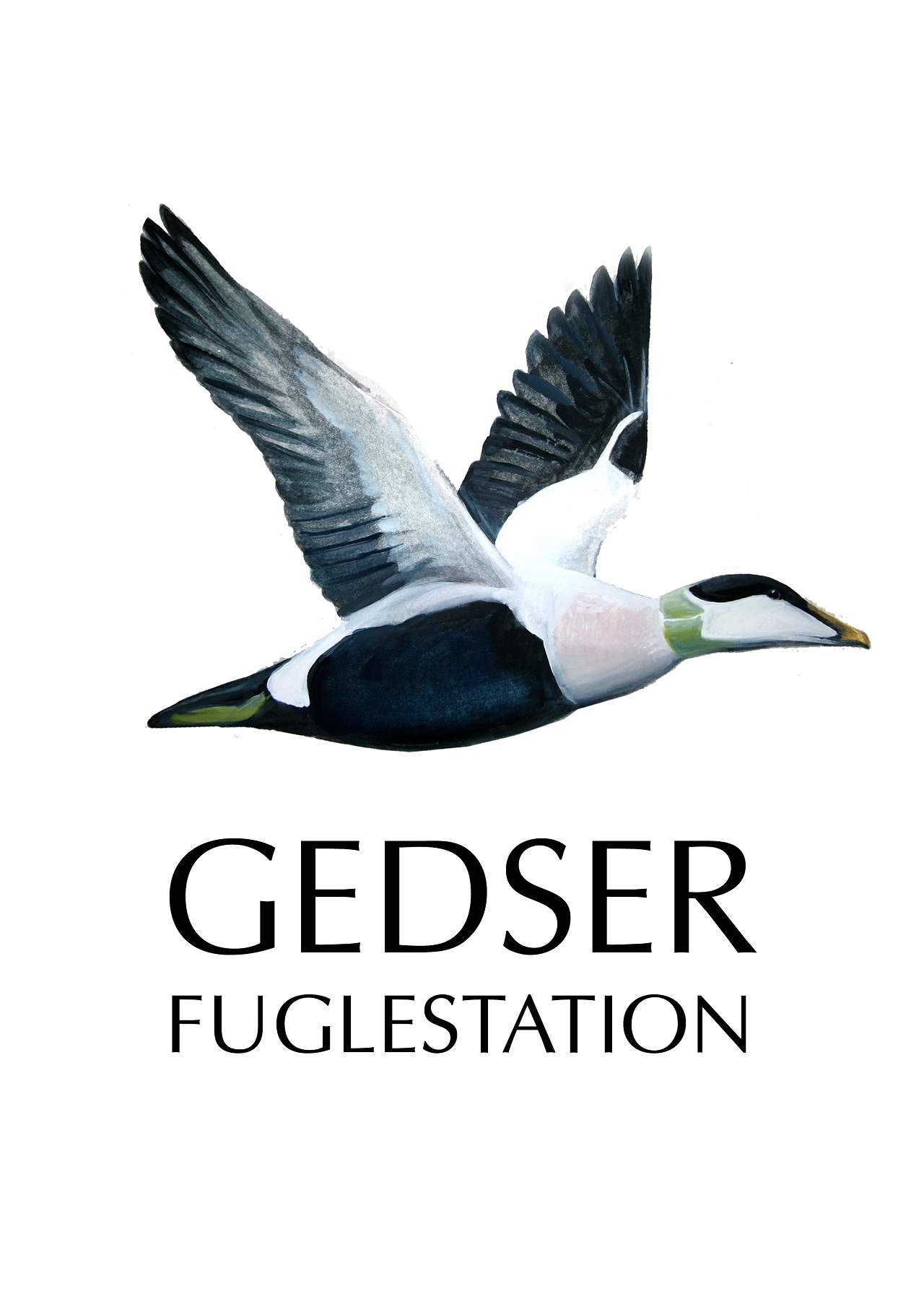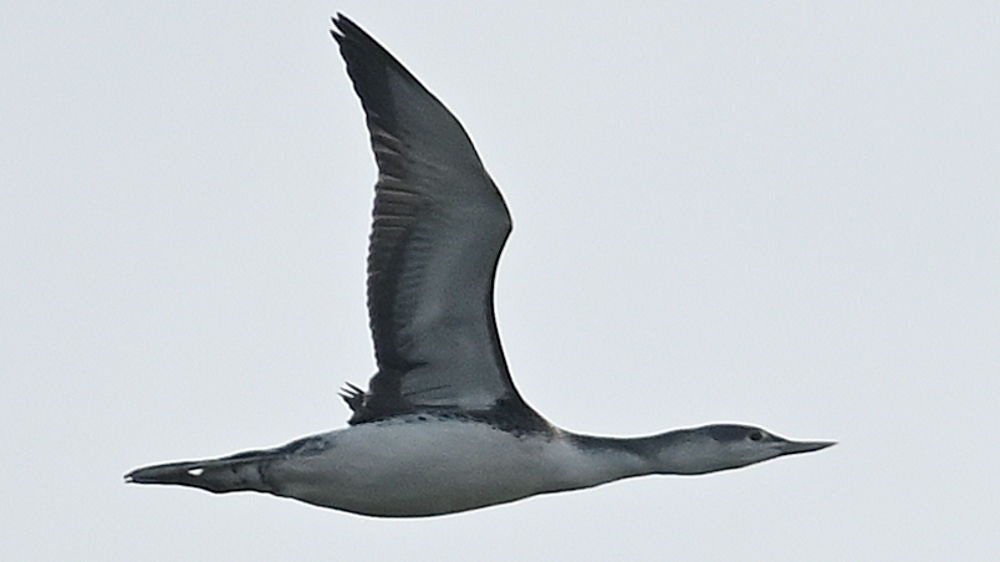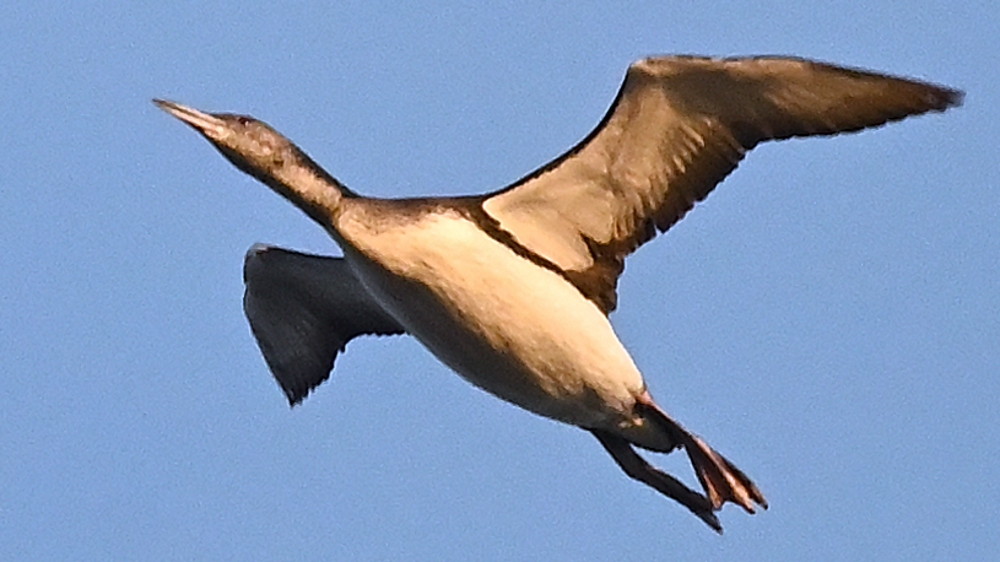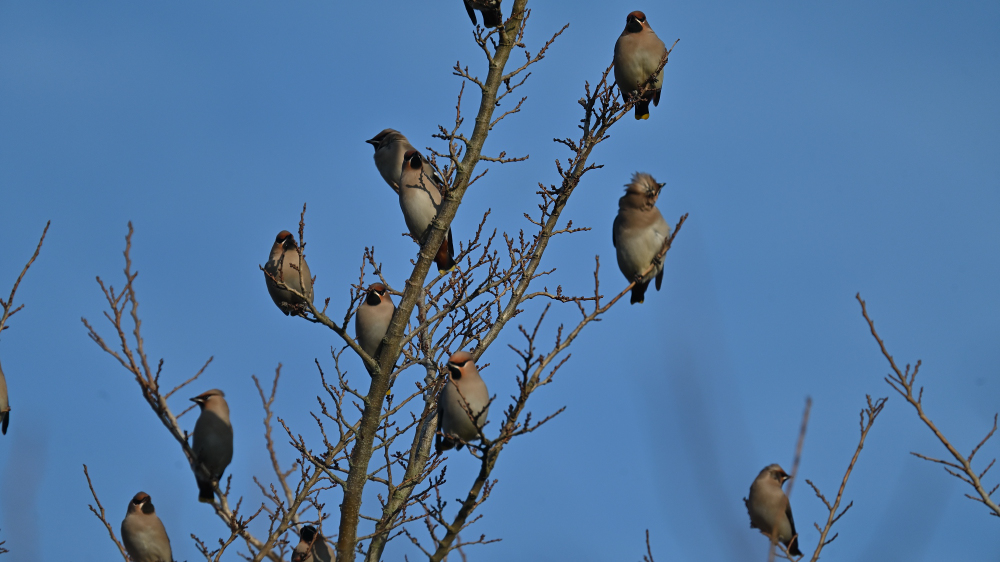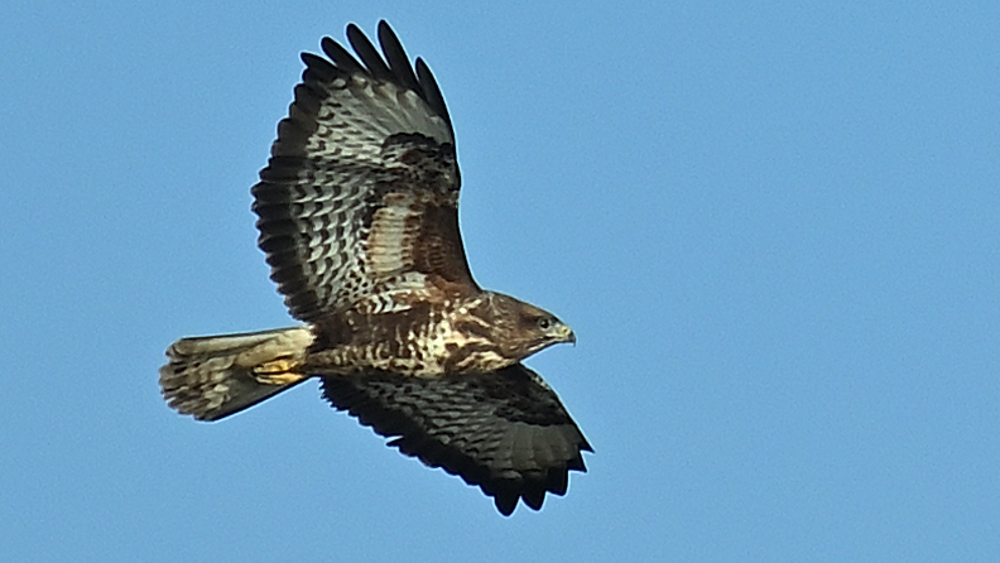Gedser Fuglestation Blog
Her på Gedser Fuglestations blog bringes korte nyheder i dagbogsformat om hændelser på fuglestationen.
451.000 fugle i løbet af 676 timer
Trækket på Odden: Årets sidste tælling i standardtiden gav et uventet lavt resultat med nogle hundrede fugle på træk. Vi kunne sige, at det fint illustrerede, at trækket er forbi, men det var nok snarere på grund af svag vind, eller det var en tilfældighed. Vi var fem med tilknytning til fuglestationen, idet Lise, der har været med til at ringmærke og tælle træk tidligere i efteråret, dukkede op for at opleve trækket på den sidste dag.
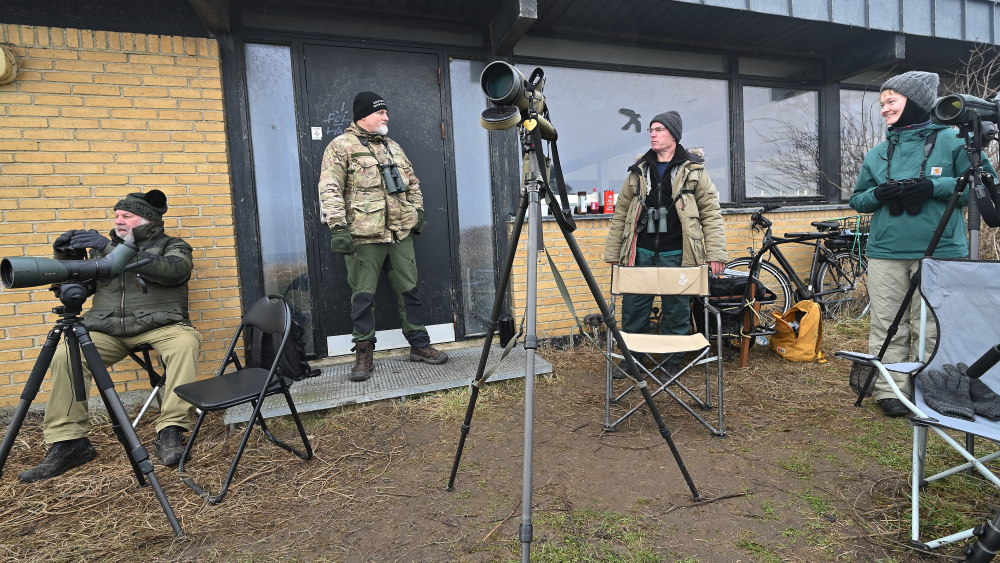
Vi startede efterårets standardtællinger på Gedser Odde 10. august og har med forskellige bemandinger af frivillige registreret 451.501 fugle på træk i løbet af lidt over 676 timer. Selv om det kan se imponerende ud, er det 110.000 færre fugle end gennemsnittet per efterår siden 2019. Tallene er fra den hollandske database Trektellen, hvor vi indtaster det meste i felten, før vi lægger dagens tal ind i DOFbasen, som er mere præcis, men Trektellen giver alligevel et ganske godt indtryk af, hvordan det er gået.
For Ederfuglene (Somateria molissima), som udgør vores største træk ud og ind af Østersøen gælder, at vi har set 164.064 passere Gedser Odde i dette efterår. Det er færre end de 176.553, vi så i efteråret 2024, men det er over gennemsnittet på 159.876 Ederfugle. Sortænderne (Melanitta nigra) har vi set flere af i dette efterår med 44.787 mod 33.715 i 2024, og det bringer årets resultat op over gennemsnittet på 43.293. Fløjlsænderne (Melanitta fusca) har der også været flere af i trækket med 5.069 i dette efterår mod 3.993 i efteråret 2024 og et gennemsnit på 3.308.
For de Rødstrubede Lommer (Gavia stellata), som stadig er i gang med trækket, selv om det er ved at ebbe ud med 88 fugle på denne sidste tælledag, gælder, at vi har registreret 6.067 i løbet af efteråret. Det er under gennemsnittet på 6.561, men betydeligt bedre end i efteråret 2024 med 4.772 og efteråret 2023 med 5.450.
Markante tilbagegange har vi især oplevet for nogle af rovfuglene. Dette efterårs 84 Fjeldvåger (Buteo lagopus) er langt under såvel de 272, vi så i efteråret 2024, som gennemsnittet på 192. Til gengæld har vi registreret flere Musvåger (Buteo buteo) med 392 i dette efterår mod 179 i 2024 og et gennemsnit på 269.
Spurvehøgene (Accipiter nisus) har igen i dette efterår skuffet med 1.762 fugle mod 2.051 i 2024, hvilket også var en markant nedgang og betydeligt under gennemsnittet på 3.150 af de små rovfugle, som vi er vant til at se her, der og allevegne på gode trækdage i oktober. Vi tror, at der er en sammenhæng mellem nedgange i bestande af småfugle og de Spurvehøge, der netop næsten udelukkende lever af småfugle.
Alle tal er som nævnt baseret på Trektellen. En mere præcis gennemgang af efterårets træk på basis af vores indtastninger i DOFbasen er på vej og kan snart findes på Gedser Fuglestations hjemmeside.
Tak til alle, der følger vores arbejde på bloggen, i DOFbasen og på Trektellen (omkring 100 opslag per dag, som formentlig især er udtryk for en udenlandsk interesse). Det er virkelig inspirerende og med til at drive arbejdet, at vi kan se en interesse for det træk, vi arbejder med på fuglestationen.
I alt blev det på den sidste dag til 762 fugle på træk fordelt på 27 arter.
Se dagens observationer fra Gedser Odde i DOFbasen.
Folk på stationen: Lise Mastrup, Mads Elley, Gert Juul Jeppesen, Henrik Jørgensen, Ole Friis Larsen.
Godt selskab på hele Nordens sydligste punkt
Trækket på Odden: Til den næstsidste tælling i denne standardsæson var vi fem med tilknytning til fuglestationen ude i læ ved den gamle marinestation, som oven i købet er hele Nordens sydligste bygning, så det blev først og fremmest en hyggelig formiddag, men der var også fin trafik af trækfugle over havet af især Sortænder (Melanitta nigra), Fløjlsænder (Melanitta fusca), Toppede Skalleslugere (Mergus merganser) og Rødstrubede Lommer (Gavia stellata), men også Ederfugle (Somateria mollissima), som var de vanskeligste at sortere i gennemtrækkende fugle og rastende fugle, som flyttede omkring efter strøm og trafikken af lodsbåde.
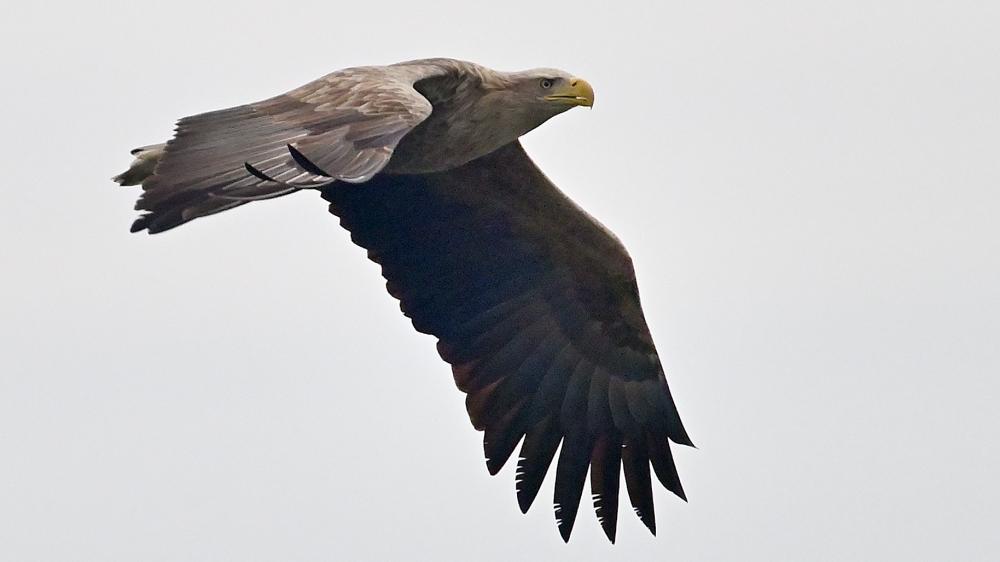
En adult/voksen Havørn (Haliaeetus albicilla) kom ind fra havet tæt forbi os. Vi noterer Havørnene som trækfugle af tradition; egentlig er de ikke trækfugle i Europa, og det er mest omstrejfende unge fugle, vi ser. De flyver efter, hvor der er bedst chancer for at blive mætte. Nogle gange ser vi dem også på jagt ude over havet, hvor de prøver at finde og fange afkræftede fugle på vandet. Dagens adulte/voksne Havørn kan også have været en tur ude at lede efter bytte på vandet, men den kan også udmærket være fløjet over fra Tyskland. Vi ved fra fugleinfluenza og andre situationer, hvor ørne i ynglepar er døde, at der også hurtigt dukker en ny mage op, så der findes også hele tiden enlige adulte/voksne Havørne, der strejfer omkring som ’reserver’.
I alt blev det til 2.316 fugle på træk fordelt på 23 arter.
Se dagens observationer fra Gedser Odde i DOFbasen.
Nyt fra fuglestationen: Fugleåret 2024 fra DOF BirdLife Danmark er netop udkommet. I bogen er der også et afsnit om Gedser Fuglestation. Læs det på nettet som en pdf-fil.
Folk på stationen: Mads Elley, Benny Steinmejer, Gert Juul Jeppesen, Henrik Jørgensen, Ole Friis Larsen.
En enkelt Spurvehøg i flot lys
Trækket på Odden: Tredjesidste tælling i dette års standardtid blev en kold oplevelse, selv om der egentlig ikke var noget at klage over. December har hele vejen igennem været mild indtil nu, og vi har været forskånet for sne, is og frost, men nogle dage føles vinden alligevel mere kold end andre, alt efter hvordan den rammer. Torsdag var vinden en anelse mere sydlig, og vi fandt ikke rigtig læ noget sted, hvor vi samtidig kunne passe vores arbejde.
Den første time var, som sædvanlig, præget af rokader blandt rastende fugle på havet. Det ser ud til, at de driver med strømmen om natten og starter dagen med at flyve tilbage til udgangspunktet i grupper og mindre flokke. Heldigvis ser det anderledes ud end det egentlige træk, vi bestræber os på at registrere, og vi skal tage det roligt med tællingen den første time og fokusere på de lommer og andre, der ser ud til at trække igennem fra morgenstunden.
De rastende fugle flyver i øvrigt op i tusindvis nu, når en lodsbåd sejler gennem de områder, hvor de ligger. Vi anslog i dag, at der var mindst 5.600 Ederfugle (Somateria molissima) ud for Gedser Odde. Desuden så vi Sortænder (Melanitta nigra), Fløjlsænder (Melanitta fusca), Havlitter (Clangula hyemalis) og andre andefugle, men i langt mindre målestok.
Lommerne er den store udfordring i decembertællingerne. De kan ligne hinanden til forveksling, vi ser dem ofte i modlys og på stor afstand. Få af dem flyver så tæt på, at vi kan arbejde med flere detaljer i bestemmelsen. Den Rødstrubede Lom (Gavia stellata) øverst kom forbi torsdag med opadvendt næb og tydeligt øje omkranset af hvidt. Den Sortstrubede Lom så vi onsdag med kraftigere fremtoning i det hele taget, men også et kraftigere næb, der pegede mere lige fremad, samt rent hvide lår. Den mørke underside på halsen skulle også være en karakteristisk forskel fra Rødstrubet Lom ifølge vores litteratur. Foto: Ole Friis Larsen/GFU
Trafikken af trækkende fugle forekom umiddelbart noget mindre end i de foregående dage, og det fik vi bekræftet af dagens tal, som dog bød på nogen trafik af gæs, Sortænder med over 900 og lommer med over 130. Dagens fugl var måske den ene Sortstrubede Lom (Gavia arctica), der kom forbi lige før lukketid.
Men en ung Spurvehøg (Accipiter nisus) med klare gule øjne var også en flot oplevelse, da den et øjeblik landede på marken og kiggede sig omkring, før den forsvandt ind mod fuglestationen, hvor den formentlig skræmte de rastende Silkehaler (Bombycilla garrulus) langt ind mod Gedser. Vi så dem fra Odden og vi kunne se på registreringerne via vores automatiske lydoptager i haven, at de havde været det meste af formiddagen ved deres ellers faste træ. Heller ikke en mindre flok Hjejler (Pluvialis apricaria), der holdt til på marken, brød sig om Spurvehøgen, som fik dem til at lette og flyve omkring, indtil den var væk.
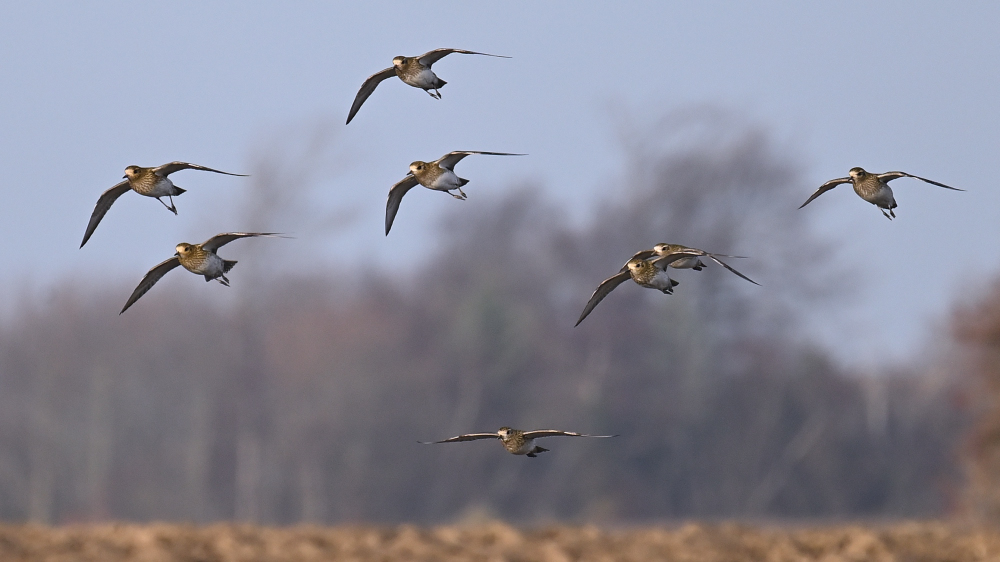
I alt blev det til 2.005 fugle på træk fordelt på 26 arter.
Se dagens observationer fra Gedser Odde i DOFbasen.
Folk på stationen: Henrik Jørgensen, Ole Friis Larsen.
Silkehaler på udflugt
Trækket på Odden: Vi taler tit om, hvilken art, vi skal udpege som dagens fugl, når vi er ude at tælle trækket, men det er ikke altid, vi kan snævre flere gode oplevelser ind til en enkelt kandidat. Denne onsdag kunne det være Silkehale (Bombycilla garrulus), mest fordi vi så en flok på omkring 65 trække ud over havet, og det er et syn, som man ikke kan gøre sig håb om et se hvert år. Her kommer flokke af Silkehaler hvert år, og der er meldinger om op til 150 sammen i Gedser i den seneste tid, hvor de bliver set i haver, når de raster og spiser bær, men det er altså sjældent at se dem flyve ud over havet.
Da vi kom hjem fra dagens arbejde på Odden, var det klaret op, og i solskinnet så et halvt hundrede andre Silkehaler meget elegante ud, mens de åd røde bær fra hvidtjørnebuske i fuglestationens have. I fuglestationens have har Silkehalerne hvert år det samme træ som base, og de er som regel lette at komme tæt på, når bare man nærmer sig langsomt og stille.
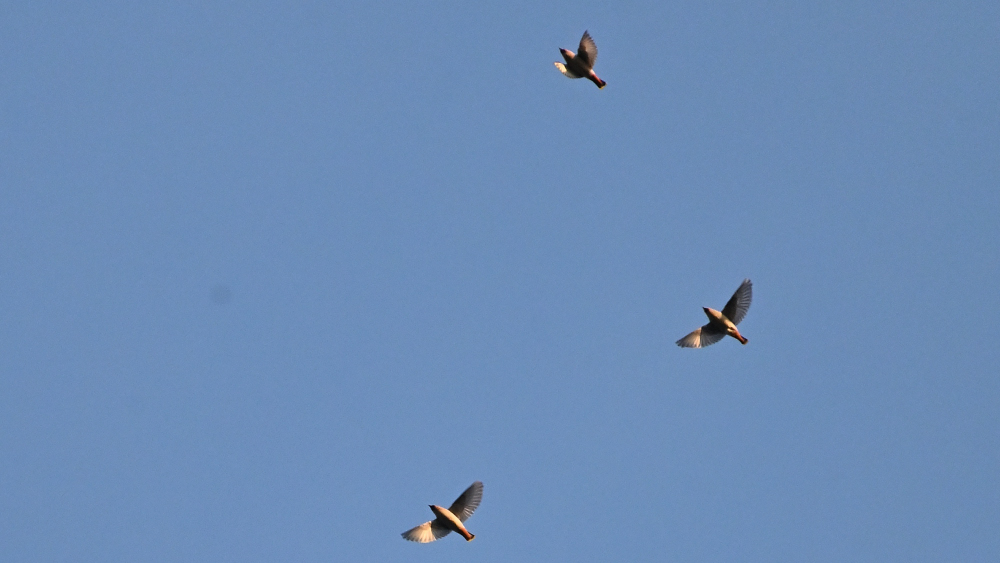
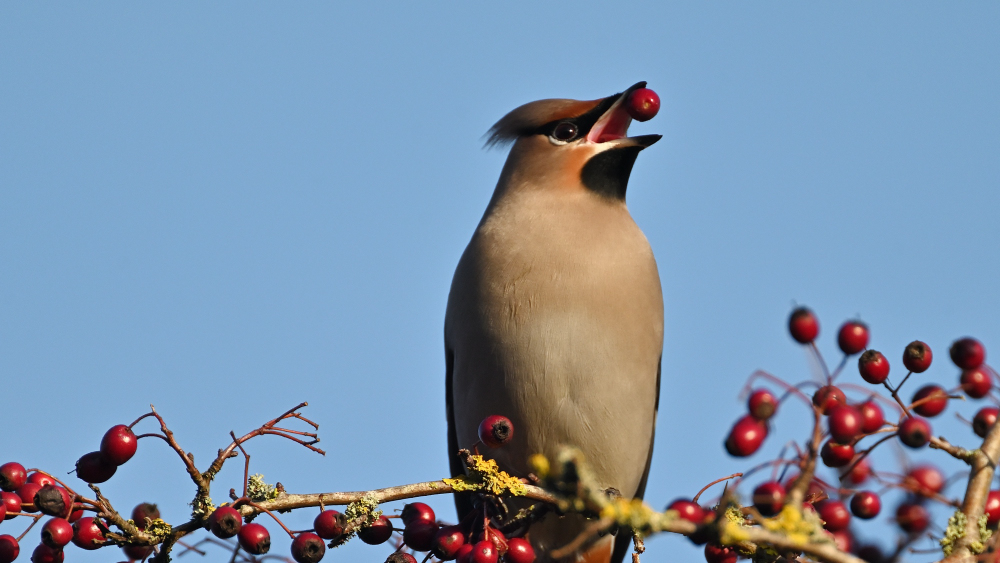
Derfor kan Silkehale sagtens være dagens fugl på Gedser Odde.
På Odden så vi i øvrigt et livligt træk, og vi var faktisk tre fra fuglestationen, idet vi kom i godt selskab med Oliver Bøgh Jensen, som var på fuglestationen i foråret og flere gange er vendt tilbage i løbet af efteråret for at opleve det træk.
Trods opklaring og solskin kom der kun få rovfugle – og fugle fra land i det hele taget. Fint var det derfor med en adult/voksen Vandrefalk (Falco peregrinus), som ganske vist ikke trak ud, men var et flot og kraftfuldt skue over markerne. Over havet var der stadig et pænt træk af lommer med lidt flere Sortstrubede Lommer (Gavia arctica) – 7 – end i de seneste dages træk, og over 200 af de rødstrubede. Glade var vi også for 267 Bjergænder (Aythya marila). Det forekommer, at de trækker ekstra sent i år med det seneste par dages tal, og det er tvivlsomt, om vi når at se det træk kulminere, før vi tæller for sidste gang i år i standardtiden på lørdag.
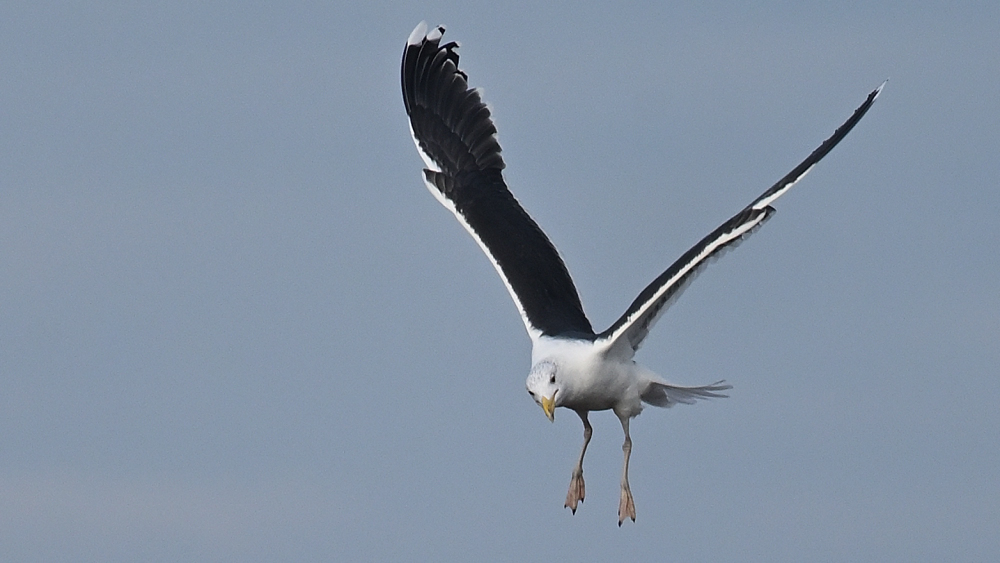
I alt blev det til 3.718 fugle på træk fordelt på 31 arter.
Se dagens observationer fra Gedser Odde i DOFbasen.
Folk på stationen: Henrik Jørgensen, Ole Friis Larsen.
Lys, solskin, blå himmel - og mange fugle i farver
Trækket på Odden: Vi gik ud til tællingen i måneskin på en klar, men også kold morgen med mere vind fra syd, end vi havde forventet. Efterhånden tabte vinden dog styrke, og vi fik solskin, som ligefrem tog noget af kulden var den aftagende vind. Vi havde ventet noget rovfugletræk med udsigten til blå himmel og svag vind; vi fik også lidt, men ikke meget.
Vi havde ikke nogen store forventninger til havtrækket, men fik et af de største træk af de sorte og hvide Fløjlsænder (Melanitta fusca), som vi har oplevet i en standardtid, nemlig 675. Også Sortænderne (Melanitta nigra) overraskede med et uventet stort træk på næsten 1.900 fugle. Desuden lagde lommerne ud med et hårdt udspil på næsten 200 fugle i løbet af tre kvarter omkring solopgang. De fløj langt ude, tæt på og direkte ind over os, så vi måtte koncentrere os om at få lige netop dem talt godt.
Bemærkelsesværdigt var det også med tæt på 150 Bjergænder (Aythya marila) samt et godt ryk af Ederfugle (Somateria mollissima) på over 1.000 fugle.
Mest af alt nød vi dog at kunne se farver på fuglene i det smukke solskin efter mange dage med grå silhuetter i dunkelt lys.
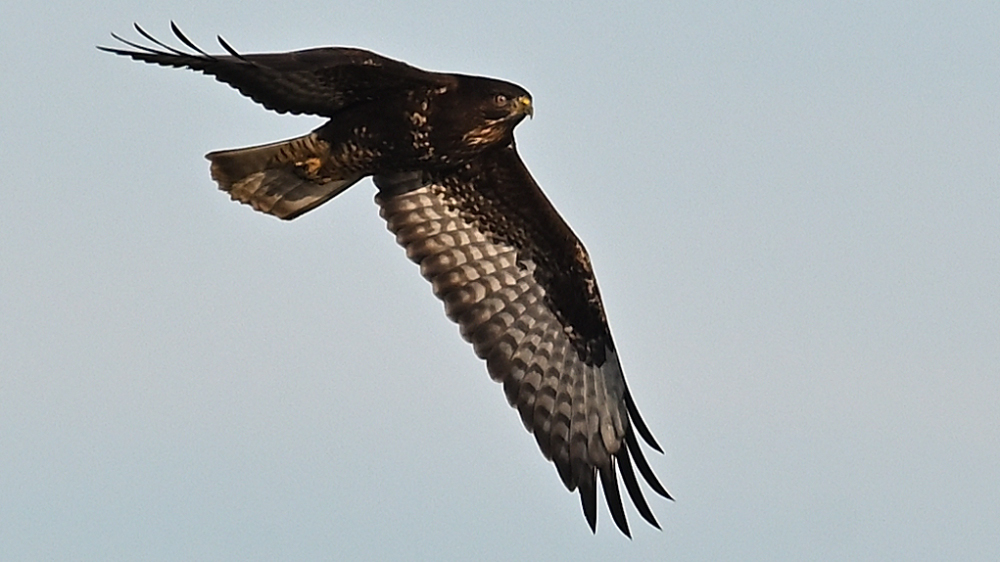
Ud over et lille rovfugletræk på to Musvåger (Buteo buteo) og en Rød Glente (Milvus milvus) så vi i et kort glimt en Dværgfalk (Falco columbarius) lavet over markerne, og den lokale Tårnfalk (Falco tinnunculus) velsignede os ved at muse ganske tæt på vores observationspost og oven i købet i godt medlys (på fransk og italiensk siger man, at musende rovfugle ’gør heligånden’, fordi de minder om præsten, der velsigner folk i kirken).
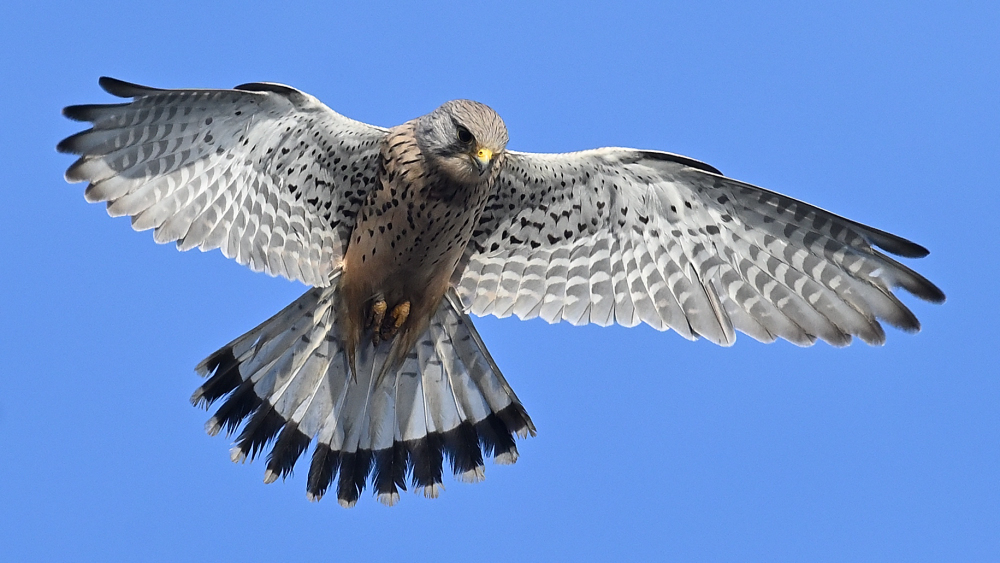
I kikkert og på billeder kunne vi fint se, at Tårnfalken er ringmærket – formentlig på fuglestationen – men vi kunne ikke aflæse nummeret, så vi kan ikke være sikre.
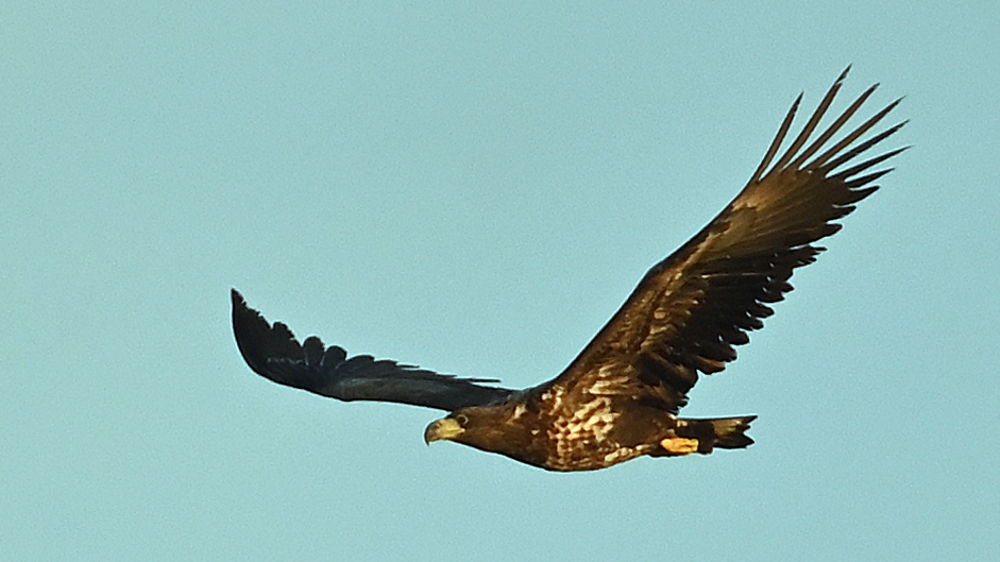
I alt blev det til 4.627 fugle på træk fordelt på 31 arter.
Se dagens observationer fra Gedser Odde i DOFbasen.
Folk på stationen: Henrik Jørgensen, Ole Friis Larsen.
Havlitter, Skarver og andre vanskelige arter
Trækket på Odden: Tusinder af fugle ligger nu på vandet ud for Gedser Odde, hvor de flyver op, når de bliver bange for en af lodsbådene, eller de driver et stykke med strømmen, hvorefter de flytter tilbage til udgangspunktet. Det giver en masse trafik af Ederfugle (Somateria molissima), Sortænder (Melanitta nigra), Fløjlsænder (Melanitta fusca) og andre arter, som egentlig er i mål for deres træk til overvintring og ikke behøver at rejse videre. Desuden kommer der hver morgen hundredvis af Skarver (Phalacrocorax carbo), som overnatter på Rødsand, men søger føde ved Gedser Rev. Nogle gange ser vi også tusindvis af gæs, som endda flyver et stykke ud over havet, før de vender tilbage ind over markerne, hvor de leder efter mad.
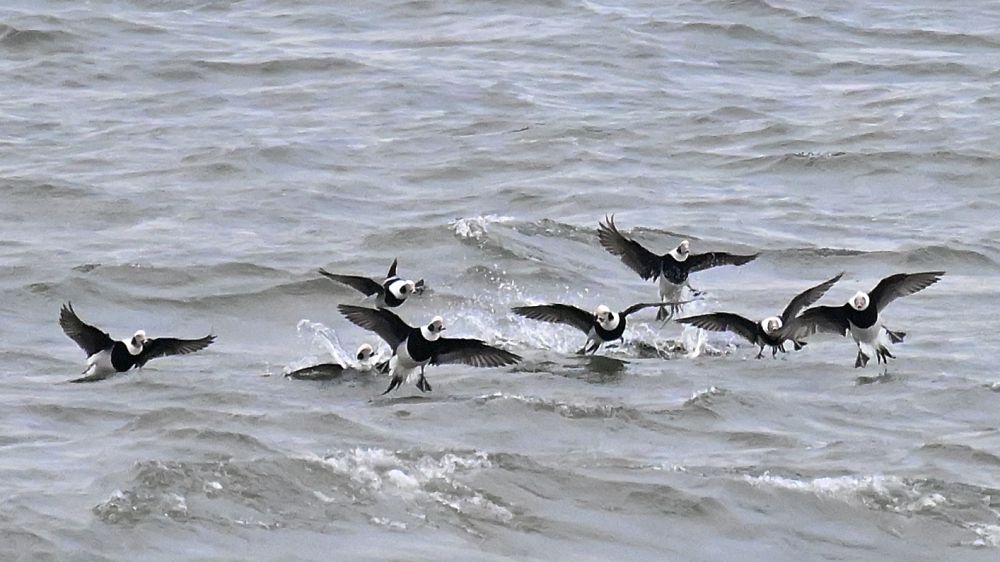
Det er en del af udfodringen ved at tælle træk, at vi både skal skelne mellem fugle, som flytter sig over en kort afstand i området, og fugle, som fortsætter gennem kaos af opflyvende rastefugle i et egentligt videretræk. Blandt andet må vi se på fuglenes formationer og hastigheden, de bevæger sig med. Let er det ikke, og det er genstand for mange diskussioner. For Skarverne ser vi for eksempel på, om de runder sydspidsen med kurs mod Rødsand, eller de fortsætter mod Tyskland i sydlige og sydvestlige retninger, samtidig med, at vi holder øje med, om de lander på vandet kort efter, eller de forsvinder langt ud over havet.
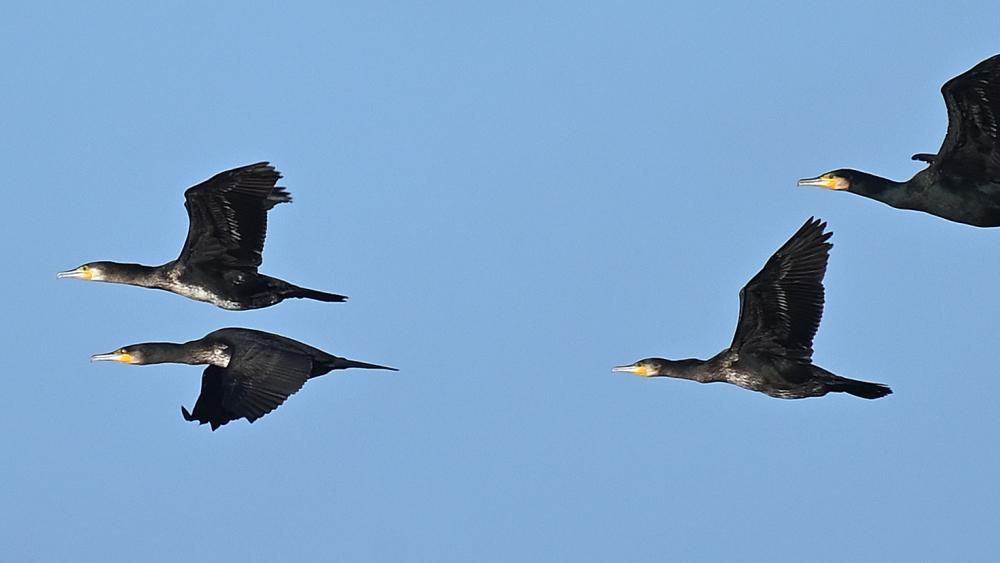
Det er (næsten) aldrig kedeligt.
Mandag oplevede vi en opklaring og et fald i vindstyrken. Det gav os et større træk af Ederfugle, end vi ellers har set i de seneste dage. Desuden kom der en del Hættemåger (Chroicocephalus ridibundus) i flere småflokke, som vi registrerer, mens vi holder udkig efter de mindre Dværgmåger (Hydrocoloeus minutus), som er en ’specialitet’ for Gedser Odde, men som vi ikke har set mange af i den seneste tid. Trækket af lommer var pænt med over 220.
I alt blev det til 2.250 fugle på træk fordelt på 30 arter.
Se dagens observationer fra Gedser Odde i DOFbasen.
Folk på stationen: Henrik Jørgensen, Ole Friis Larsen.
Julehygge for de frivillige
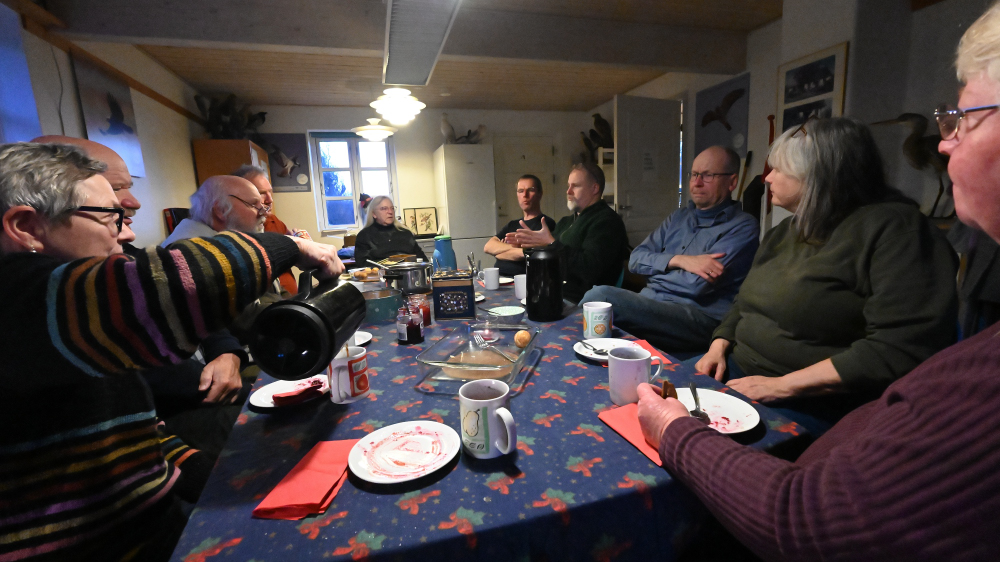
Nyt fra fuglestationen: Søndag eftermiddag var der julehygge med æbleskiver og glögg på fuglestationen for de faste frivillige, som ikke kun omfatter træktællere og ringmærkere, men også stationens ledelse og folk, der laver alt muligt andet – for eksempel bager kager til arrangementer og deltager i praktisk arbejde ved arrangementer, syr og broderer ting til vores butik og deltager i vedligeholdelse af haven. Initiativet til julehyggen blev taget for få år siden og har lynhurtigt udviklet sig til en fin tradition.
Trækket på Odden: Vinden bevægede sig på grænsen mellem frisk og hård, og der var skum på bølgerne, men den største forskel i forhold til lørdag var snarere, at der var færre skyer, og vi fik en mærkbar opklaring, da solen kom frem. Morgentrækket begyndte fint med en god trafik af lommer, men det hele gik næsten i stå efter halvanden time, og det sidste par timer, kom der næsten ingen fugle på træk. Det blev nogle få større ryk af gæs og Skarver (Phalacrocorax carbo), der bragte dagens samlede tal op over tusind.
Vi troede, at opklaringen ville bringe i hvert fald nogle få rovfugle ned til trækforsøg fra Odden, men enten var der ikke nogen i nabolaget, eller også var vinden for kraftig. To af de tre, vi så, var den lokale han Tårnfalk (Falco tinnunculus) og en meget mørk voksen/adult Musvåge (Buteo buteo), som vi anser for den, der blev ringmærket på fuglestationen for flere år siden og genfanget sidste år. Desuden så vi en helt ung 1k (første kalenderår) Havørn, som kom flyvende langs kystskrænten med en fuld kro – en stor bule på halsen efter et større måltid.
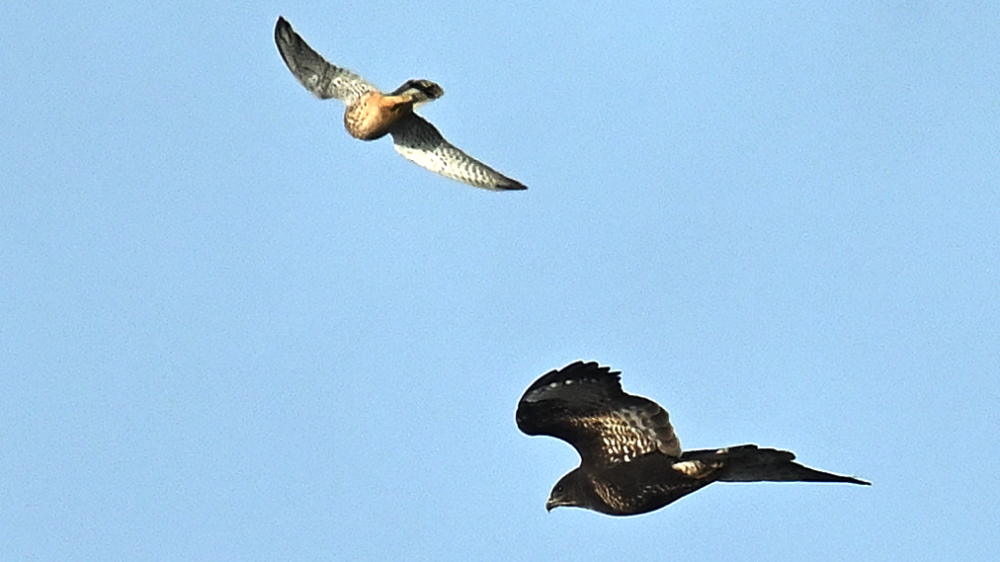
Selv om trækket over havet hurtigt ebbede ud i solskinnet, nåede vi at registrere næsten to hundrede Toppede Skalleslugere (Mergus merganser) og lige under 90 lommer. Desuden var vi glade for 17 Dværgmåger (Hydrocoloeus minutus) i to flokke. Det var et stykke tid siden, vi havde set Dværgmåger, som ellers ikke er noget sjældent syn i december.
I alt blev det til 1.442 fugle på træk fordelt på 28 arter.
Se dagens observationer fra Gedser Odde i DOFbasen.
Folk på stationen: Anne Marie Reith, Tina Elley, Ulla Kayser, Vibeke Holst Jensen, Bo Kayser, Mads Elley, Gert Juul Jeppesen, Søren Mygind, Poul Hauch Henrichsen, Henrik Jørgensen, Ole Friis Larsen.
En stor flok lommer, men hvor er rovfuglene?
Trækket på Odden: Dagen begyndte fint med et ret flot træk af lommer og endte i regn med stort set ingen fugle i havtrækket. Vi var de to faste tæller i godt selskab med to andre frivillige med tilknytning til fuglestationen, nemlig Bo Kayser og Gert Juul Jeppesen, en stor del af tiden.
I det overskyede vejr så vi fire gange så mange fugle på træk som dagen før og flere arter. Selv om vejret umiddelbart forekom at være det samme begge dage, var der mere vind lørdag, end der var fredag, og det var måske en nærliggende forklaring på forskellen.
Mest bemærkelsesværdigt var et større træk af lommer end i de foregående dage. En flok på over 40 Rødstrubede Lommer (Gavia stellata) var både et imponerende skue i sig selv og et stort bidrag til dagens samlede antal på 280 mod sydvest. Dertil kom 4 Sortstrubede Lommer (Gavia arctica). Bemærkelsesværdigt var det også med et ganske pænt træk af svømmeænder med 45 Pibeænder (Mareca penelope), 50 Gråænder (Anas platyrhynchos) og 8 Krikænder (Anas crecca). Lidt uventet så vi også 3 Gravænder (Tadorna tadorna).
Desuden så vi flere flokke af Skarver (Phalacrocorax carbo), som vi besluttede at registrere som trækkende fugle, fordi de kom forbi Odden i flere større formationer inden for kort tid og ikke forekom at have noget at gøre med de overvintrende Skarver, der hver morgen kommer til Odden fra Rødsand for at lede efter mad og raste på stranden.
Med kun en uge tilbage af årets standardtid er der ingen grund til at tro på større ændringer i de tal, vi har registreret for efterårstrækket af rovfugle ved Gedser Odde. Vi har næsten ingen set i den seneste tid, og det tyder på, at vi ender med meget lave tal for især tre arter.
Indtil nu har vi registreret 37 Blå Kærhøge (Circus cyaneus) mod 57 sidste år og et årligt gennemsnit på 65 i standardtiden. Det kan være, at mildt vejr har fristet dem til at forkorte trækket og blive længere nordpå.
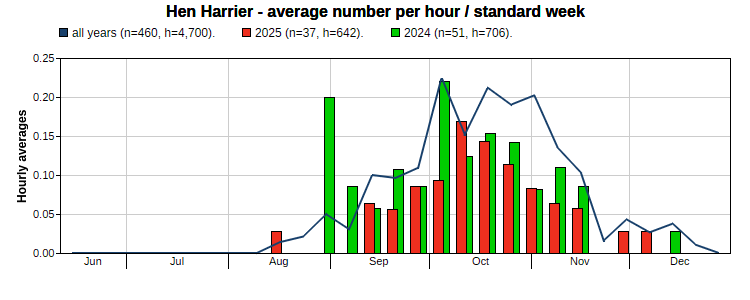
Trækket af Blå Kærhøge har i dette efterår (røde søjler viser fugle per time) fulgt normalkurven, men blot været lavere. De grønne kurver viser, at sidste års træk især var mere intenst i slutningen af august og i september. Kilde: Trektellen
Værre ser det ud for Fjeldvågerne (Buteo lagopus). Dem har vi indtil nu set 84 af i dette efterår mod 273 sidste år og et årligt gennemsnit på 193. Antallet af Fjeldvåger svinger ganske givet med forekomsten af lemminger i det nordlige Norge, Sverige, Finland og Rusland, men når tallet også ligger betydeligt under gennemsnittet, må vi krydse fingre for, at de nordlige våger også har forkortet deres træk og opholder sig længere nordpå i det milde vejr.
Endelig er der Spurvehøgene (Accipiter nisus). De har været i kraftig tilbagegang på trækket ved Gedser Odde i flere år, og tilbagegangen er fortsat markant i dette efterår med bare 1.773 af de iltre små høge mod 4.480 i 2022, 3.168 i 2023 og 2.095 i 2024 – altså yderligere 300 færre i år. Det årlige gennemsnit er på 3.163. Der kan være mange forklaringer, hvor klima og vindretninger også spiller ind, men der er ganske givet også en sammenhæng med faldet i småfugle, som til gengæld er vendt til en opgang fra sidste år til dette efterårstræk. Det har Spurvehøgene måske ikke kunnet reagere på i år, og derfor bliver det interessant at følge trækket af dem næste efterår.
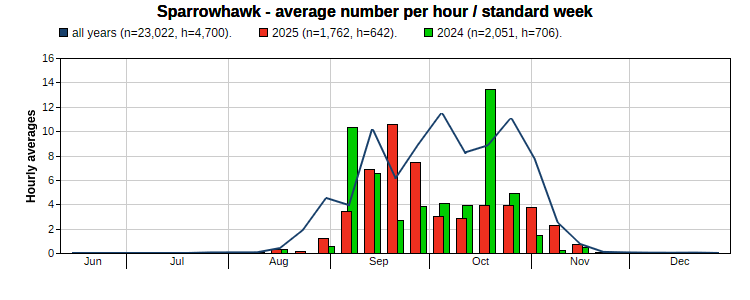
De røde søjler viser, at intensiteten i trækket af Spurvehøge per time i standardtiden så lovende ud i september, men derefter især har ligget langt under normalkurven i oktober. De grønne søjler viser til sammenligning trækket af Spurvehøge i 2024. Kilde: Trektellen
I alt blev det fredag til 1.881 fugle på træk fordelt på 27 arter.
Se dagens observationer fra Gedser Odde i DOFbasen.
Folk på stationen: Henrik Jørgensen, Ole Friis Larsen.
På sporet af Viberne
Trækket på Odden: Fredag blev mest af alt en hyggelig dag på Odden for de to fra fuglestationen i godt selskab med folk, der har en lang tilknytning til fuglestationen, nemlig Gert Juul Jeppesen og Benny Steinmejer. Der var næsten ingen vind, og derfor var det heller ikke spor koldt at stå godt i læ i seks graders varme. Vi så ikke mange fugle, men så var der tid til at udveksle erfaringer i bestemmelse af dem.
Efter en periode med et usædvanligt stort træk af Viber (Vanellus vanellus) så vi kun fem på træk, men bare nogle få kilometer væk, så en observatør 1.500 rastende Viber ved Bøtø, og det var en interessant oplysning for os, for det tyder på, at der enten er stor daglig udskiftning i fuglene ved Bøtø, eller at de tusinder af Viber, vi har set på træk ved Gedser Odde, er kommet ude fra havet ind over Odden og trukket videre uden at have nogen forbindelse til de rastende fugle ved Bøtø.
På appen Animal Tracker har vi fundet flere finske Viber med gps-sendere, som tyder på, at i hvert fald en del af de Viber, vi har set på træk i dette sene træk ved Gedser Odde er kommet netop fra Finland. Her er to eksempler:
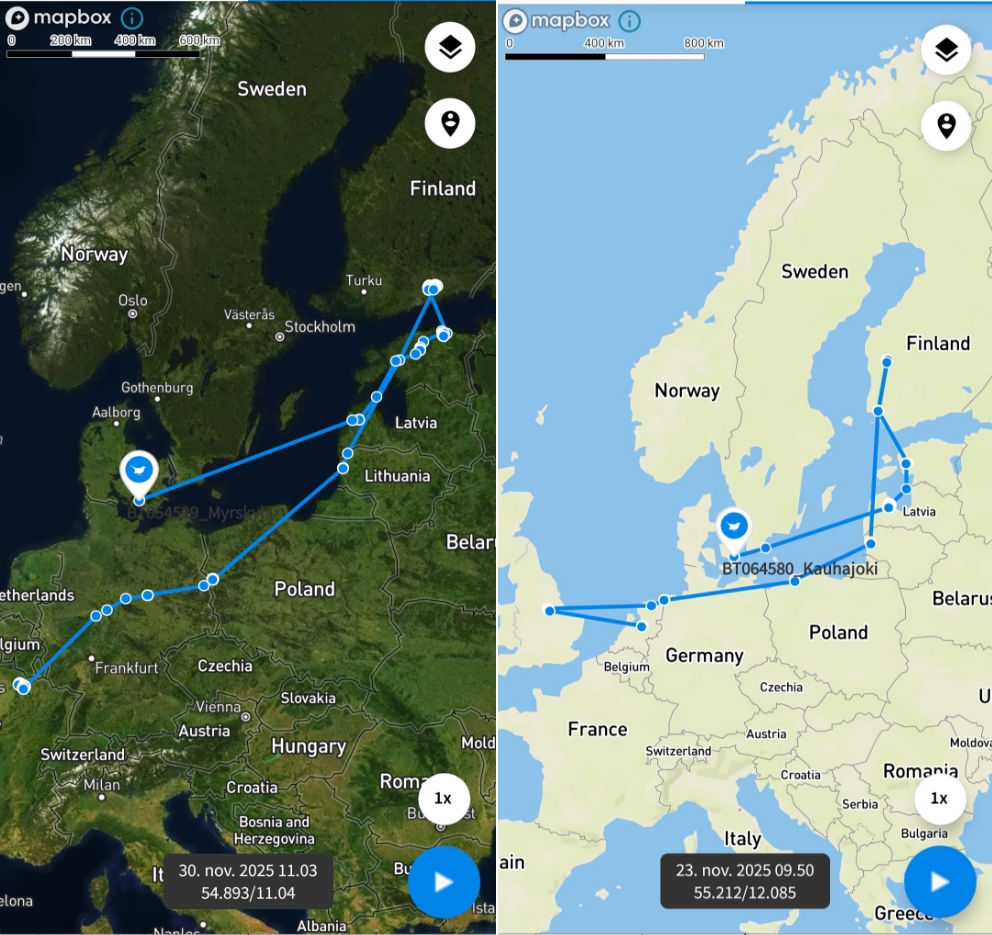 Viben ’Myrskylä’ trak 24. november fra Estland til Øland i Sverige, og 29.-30. november videre ind over Danmark, hvor der senest er registreret et signal fra dens sender nord for Nakskov Fjord 6. december. Myrskylä fløj i øvrigt i foråret fra Nordøstfrankrig, hvor den havde været i to måneder, til en ynglelokalitet tæt på sydkysten af Finland, hvorfra den i slutningen af september fløj til Estland for at raste der i flere uger, før den kom til Danmark langs sydkysten af Sverige. Viben til højre på illustrationen, ’Kauhajoki’, kom 21. november til et område syd for Præstø Fjord, hvor den har været siden. Det seneste signal fra den Vibe er fra 6. december. Denne Vibe startede i øvrigt sit forårstræk i Holland ved at flyve til England og derfra mod Øst via Estland til en ynglelokalitet i det vestlige Finland. På efterårstrækket trak den først mod syd til Estland, hvor den blev i flere uger, før den fløj via Sydsverige til området ved Præstø. Kilde: Animaltracker.
Viben ’Myrskylä’ trak 24. november fra Estland til Øland i Sverige, og 29.-30. november videre ind over Danmark, hvor der senest er registreret et signal fra dens sender nord for Nakskov Fjord 6. december. Myrskylä fløj i øvrigt i foråret fra Nordøstfrankrig, hvor den havde været i to måneder, til en ynglelokalitet tæt på sydkysten af Finland, hvorfra den i slutningen af september fløj til Estland for at raste der i flere uger, før den kom til Danmark langs sydkysten af Sverige. Viben til højre på illustrationen, ’Kauhajoki’, kom 21. november til et område syd for Præstø Fjord, hvor den har været siden. Det seneste signal fra den Vibe er fra 6. december. Denne Vibe startede i øvrigt sit forårstræk i Holland ved at flyve til England og derfra mod Øst via Estland til en ynglelokalitet i det vestlige Finland. På efterårstrækket trak den først mod syd til Estland, hvor den blev i flere uger, før den fløj via Sydsverige til området ved Præstø. Kilde: Animaltracker.
I alt blev det fredag til 576 fugle på træk fordelt på 22 arter.
Se dagens observationer fra Gedser Odde i DOFbasen.
Folk på stationen: Henrik Jørgensen, Ole Friis Larsen
Sjældent stort træk af Viber og Hjejlere
Trækket på Odden: Undskyld, at vi ikke har fået skrevet blog/dagbog tirsdag og onsdag. Det skyldes ganske enkelt, at der ikke var tid til det på grund af andre aktiviteter i DOF/BirdLife Danmark. Vi har dog været ude at tælle såvel tirsdag, som onsdag og i dag, torsdag, og trækket har været spektakulært med store træk af Viber (Vanellus vanellus) og Hjejler (Pluvialis apricaria), så vi er glade for at have kunnet udføre det arbejde med systematisk registrering af trækket på hele Nordens sydligste punkt.
Onsdag så vi 1.650 Viber trække samtidig ud fra Gedser Odde. De arbejdede sig op i så stor højde, at vi næsten ikke kunne se dem mere, og så forsvandt de ud over havet. Det er ny rekord for træk af Viber ved Gedser Odde.
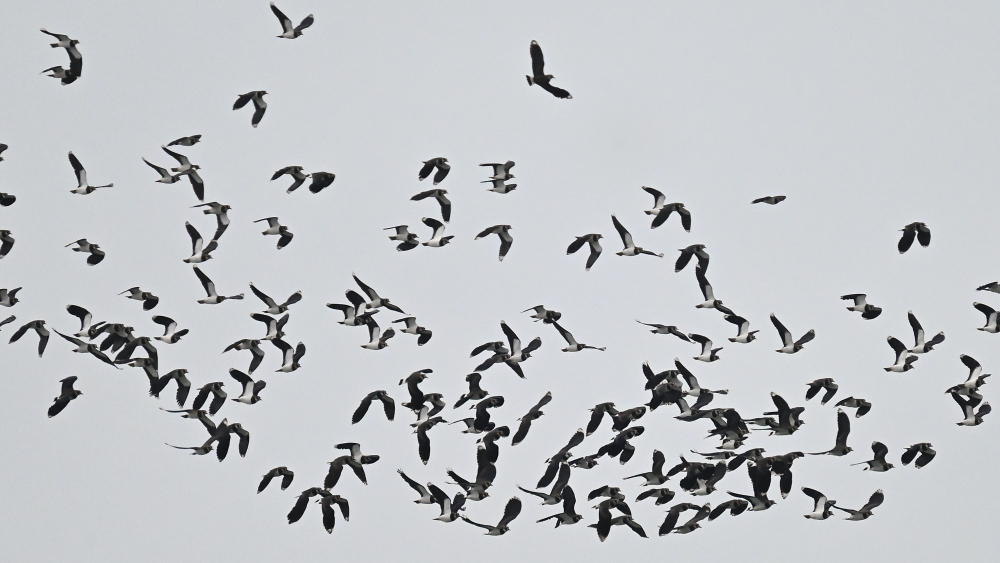
Den tidligere rekord blev sat fem dage tidligere, da holdet fra fuglestationen talte 700 Viber på udtræk 5. december i år. Faktisk har antallet af udtrækkende Viber ved Gedser Odde sat rekord fem gange i dette efterår, siden vi 29. november registrerede 325 udtrækkende fugle, så der er ingen tvivl om, at vi i den seneste tid har været vidner til et usædvanligt fænomen.
I DOFbasen skal vi helt tilbage til 15. oktober 2006, da Rasmus Due Nielsen så 300 Viber trække ud mod syd. I en søgning tilbage til 1960 forekommer ingen andre dagstotaler på over 300 Viber, end den i 2006 og dem, vi har haft i dette efterår.
Vi kan registrere det store træk af Viber og undre os, men vi kan ikke give en forklaring på, hvad der foregår. Det kan være helt tilfældigt, det kan skyldes klimaændringer, der kan være mange forklaringer. Vi kan bare pege på, at der er noget, som er anderledes, når det gælder Viberne, og så kan vi glæde os over at være vidner til en usædvanlig fugleoplevelse.
Også torsdag var der Viber, som trak ud, men det blev ’kun’ til lidt under 500, hvilket kunne tyde på, at det store træk er ved at ebbe ud. Det vil de næste dage vise.
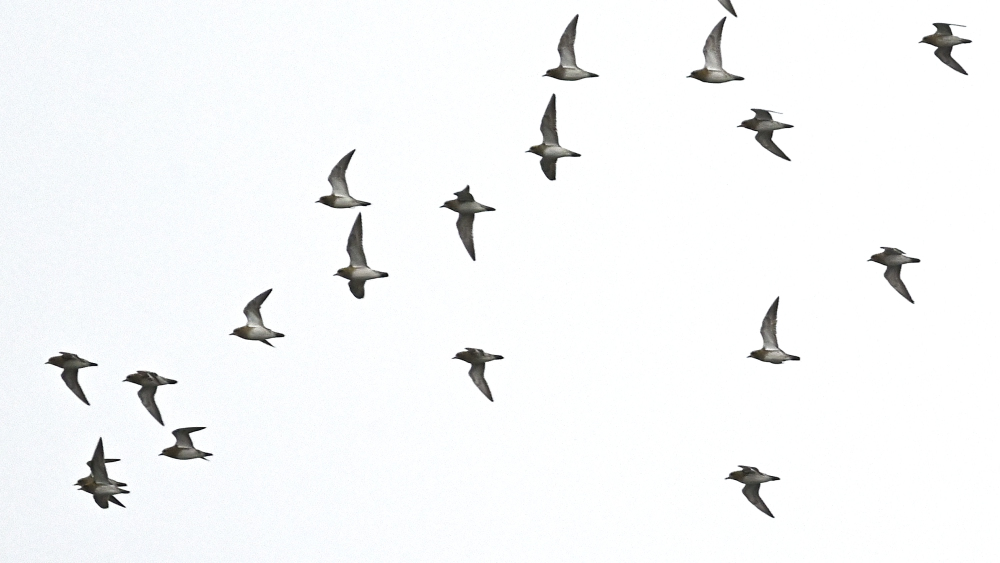
For Hjejlerne gælder, at de 2.242, som vi onsdag morgen så trække ud samtidig med den store flok Viber, også var en usædvanlig hændelse. Vi er vant til at se store flokke på mange tusinde Hjejler bevæge sig mellem Rødsand som rasteplads og marker inde på Falster, men vi er ikke vant til at se så store antal trække ud mod syd eller sydvest.
Onsdagens udtræk er det næststørste, vi har registreret i en standardtid på fem morgentimer ved Gedser Fuglestation, idet et hold sammen med Jimmy Skat registrerede 4.165 Hjejler på udtræk mod sydvest 4. oktober 2020 – senere samme dag blev der oveni talt 2.610 udtrækkende mod sydvest, men det var i en ekstratid på over seks timer. I DOFbasen er der desuden registreret et udtræk på 525 Hjejler 21. oktober 2020, da der også blev talt 790 i en ekstratid på tre timer. Derudover er der ingen tal over 500 Hjejler på en dag ved Gedser Odde i en søgning tilbage til 1960.
De seneste dages overskyede, men milde vejr har i øvrigt været præget af et fortsat pænt træk af lommer, et mindre træk af gæs af flere arter og meget lidt udtræk fra land – ud over Viber og Hjejler.
I alt blev det torsdag til 1.664 fugle på træk fordelt på 27 arter.
Se dagens observationer fra Gedser Odde i DOFbasen.
Folk på stationen: Gert Juul Jeppesen, Henrik Jørgensen, Ole Friis Larsen
